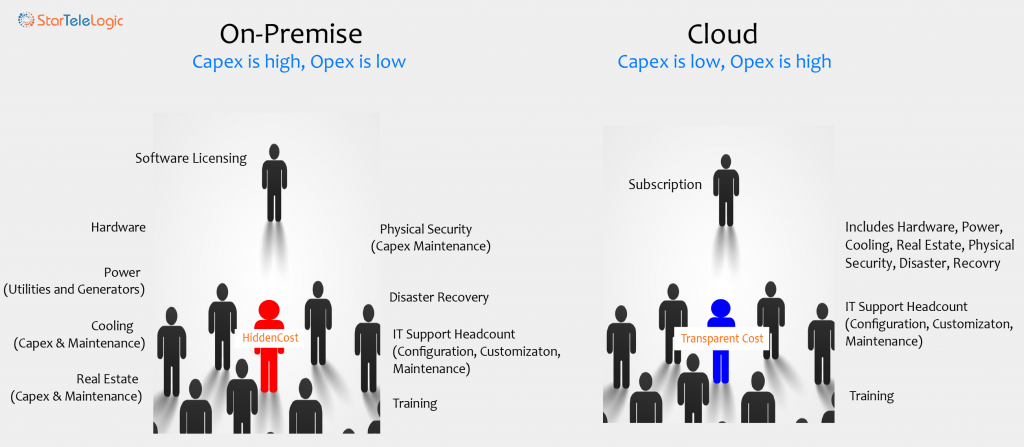Interaction with the customer via customer service functions are the frontline of any organization. Handling and managing these queries in the right manner can open up new doors to your business. Having well trained and informed contact center agents can deliver a top-class service to the customers which in turn ensure loyalty, scales up your brand value, and, to a great extent, saves on expenditures.
To keep up the pace of engagement with the customers, various industry verticals are struggling with today’s social and mobile-connected customers. There is a wide range of digital channels used by customers to interact with companies such as via mobile, social platforms, web, IVR, email, chat irrespective of the time and location. Thus, the customer in today’s era expects an instant response from companies they reach out to independent of the channel or channels used.
The ultimate benefits behind adopting cloud are; faster deployment and, cost. When businesses analyze the total cost of ownership (TCO) of the cloud versus on premise-based contact center platforms, they primarily focus on the short term cost benefits of the deployment as compared to the cost involved. For example, losses incurred in deployment of an on the premise-based platform for a period of three to six months, whereas we can quickly implement the cloud-based solution and enjoy greater cost-benefits when compared with on premise-based solution.
With the help of various insights and research, startelelogic the cloud telephony solutions and services provider will present before you a detailed analysis of cloud vs premise-based contact center TCO. In the forthcoming sections, we will cover;
-
The Quantitative Vertical: cloud versus premise-based contact center TCO based out of financial, functional, operational, and strategic considerations.
-
The Qualitative Sphere: various dimensions of cloud and premise-based contact center platforms, it incorporates the addition of new channel support along with benefits to agents and customer experience (CX).
-
Cost-effectiveness: cloud and on premise-based platforms between outsourced and hybrid contact centers.
-
Final Outcome: On the CX while leveraging cloud versus premise-based contact center solution.
Cloud V/S Premise TCO: A quantitative analysis
As there are multiple factors responsible for delivering great support experience, similarly there are multiple components to be considered when assessing the full TCO of a contact center solution.
For example, if a contact center hasn’t upgraded its PBX switch for 10 years or more, it may look for a transition to the cloud for enhanced versatility, deployment speed, and cost. Hence, the benefits of adopting a cloud-based solution should be compared to a premise-based solution on these criteria.
It is of utmost importance for us to focus on discrete TCO differences between cloud and premise-based contact centers, but on the other hand, it’s also important for us to get the big picture. As per a 2013 research by Aberdeen Group, the cloud-based deployment of the contact center cuts the annual contact center cost by 27 percent than their peers.
Contrasting between CapEx and OpEx
One of the financial advantages of shifting to a cloud-based contact center is tuning from Capital Expenditure (CapEx) for servers, software, etc. to an Operating Expenditure (OpEx) model. In general, the CapEx model requires a one-time investment in equipment apart from the support costs for the contact center applications.

However, the CapEx On-premise contact center requires a huge CapEx for its deployment. Also, there is an overlay of maintenance costs for these contact centers. On the other hand, OpEx for contact centers is required as per the user-fee that is paid by the user concerning the bandwidth utilized by the agents.
Slicing down the Cloud-based Contact Center
Implementation of a cloud-based contact center caters to our variety of benefits that we are unable to avail of in premise-based applications. A cloud-based contact center imparts potential for true agent virtualization by delivering a single point of contact for multiple platforms. It is done so without the intervention of third-party network call routing or polling technology.
The Cost-effectiveness through Cloud-Based TDM to VoIP Conversions
Most of the organizations have realized the agility and cost-effectiveness in migrating their voice and data traffic over a single network. Availing a Voice Over IP (VoIP) network offers flexible advantages to contact centers as well, which includes minimized overheads concerning operating networks during peak hours of call volume.
On the other hand, one of the greatest advantages of the cloud-based contact center is the ability to skip the transition from Time Division Multiplexing (TDM) to VoIP, about the cost and scalability offered by VoIP.
Noteworthy TCO Distinctions
It requires very little time in the cloud deployment, in general, it takes just weeks to deploy a cloud-based solution whereas, in the premise-based solution can take at least 18 to 24 months or even longer. Apart from that, for the premise-based solution, we need to have a dedicated resource team to work on it which affects the overall productivity of the organization.
Qualitative Benefits of Cloud Environment
The cloud-based contact center provides flexibility to adjust the call volumes as per their rise and fall and also supports the addition of new functionality such as new channel support.
On the cloud-based system, agents have a unified view of customer data that includes most recent interactions, and information about whether those issues were resolved satisfactorily or not. This level of support tends to provide a unique CX apart from other business benefits.
Better CX correlates to Customer Loyalty
According to Forrester Research, a 10 percent improvement in the CX can result in more than $1 billion as increased revenue. On the flip side, poor CX can cause customers to leave a brand. Forrester data unveils that nearly one-third of the company’s customers have a poor experience that could result in the loss of millions of dollars as revenue.
Building a Customer-Centric Agent Experience
A well-trained agent can deliver better CX, customers may become frustrated when agents find difficulty in accessing or delivering the right information. It’s always costly to take on board or to train new agents as it may take weeks and thousands of dollars.
As per an estimate by ContactBabel, the average agent attrition rate for contact centers in a growing economy is around 25%. Agent attrition makes it difficult to inch closer to the business targets and also adds to the recruitment and training costs. Therefore, cloud-based contact centers can help organizations scale-up the agent retention through various advancements such as providing information in a simplified manner or a flexible environment to allow the work-from-home options too.
A cloud-based contact center makes it easy for companies to analyze customer service preferences and responses to improvise a better CX. As there are various platforms that a customer uses to resolve his query, hence companies will have to be updated in terms of delivering the fast and knowledgeable response.
An all-in-one and Comprehensive Contact Center Solution
StarTele’s Telemo is an all-in-one comprehensive contact center solution that delivers outstanding business values. Telemo enables your business to benefit from:
-
A cut-off in the Total Cost of Ownership (TCO) by migrating to a simplified operational cost model.
-
Improvisation in sales and marketing decisions via comprehensive, real-time analytics with a 3600 view of the customer.
-
Reduction in client-retention cost with an advanced Net Promoter Score (NPS).
-
Enhanced customer satisfaction and loyalty and improved brand reputation.
The EndNote: Final Outcome
While looking for differences between cloud-based and premise-based contact centers, it is necessary to be optimistic as to what would be needed 18 months or even 5 years down the line. While it’s difficult to predict what the future may hold, company leaders must opt for a path that offers responsiveness and flexibility when it comes to improving CX’s.
Hence, understanding the TCO behind cloud versus premise-based contact centers is the first step towards dealing with the complexities and opportunities that lie ahead with customer support. So, are you ready to turn your contact center into a profit center? Get in touch and let Startelelogic help you choose the cost-effective cloud telephony solutions and services that are aligned with your business operations and objectives.

